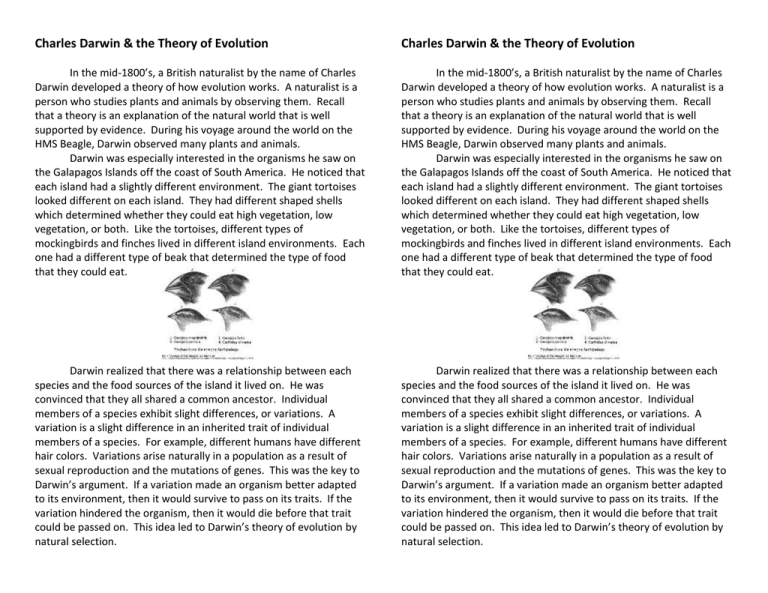Charles Darwin & the Theory of Evolution
advertisement

Charles Darwin & the Theory of Evolution Charles Darwin & the Theory of Evolution In the mid-1800’s, a British naturalist by the name of Charles Darwin developed a theory of how evolution works. A naturalist is a person who studies plants and animals by observing them. Recall that a theory is an explanation of the natural world that is well supported by evidence. During his voyage around the world on the HMS Beagle, Darwin observed many plants and animals. Darwin was especially interested in the organisms he saw on the Galapagos Islands off the coast of South America. He noticed that each island had a slightly different environment. The giant tortoises looked different on each island. They had different shaped shells which determined whether they could eat high vegetation, low vegetation, or both. Like the tortoises, different types of mockingbirds and finches lived in different island environments. Each one had a different type of beak that determined the type of food that they could eat. In the mid-1800’s, a British naturalist by the name of Charles Darwin developed a theory of how evolution works. A naturalist is a person who studies plants and animals by observing them. Recall that a theory is an explanation of the natural world that is well supported by evidence. During his voyage around the world on the HMS Beagle, Darwin observed many plants and animals. Darwin was especially interested in the organisms he saw on the Galapagos Islands off the coast of South America. He noticed that each island had a slightly different environment. The giant tortoises looked different on each island. They had different shaped shells which determined whether they could eat high vegetation, low vegetation, or both. Like the tortoises, different types of mockingbirds and finches lived in different island environments. Each one had a different type of beak that determined the type of food that they could eat. Darwin realized that there was a relationship between each species and the food sources of the island it lived on. He was convinced that they all shared a common ancestor. Individual members of a species exhibit slight differences, or variations. A variation is a slight difference in an inherited trait of individual members of a species. For example, different humans have different hair colors. Variations arise naturally in a population as a result of sexual reproduction and the mutations of genes. This was the key to Darwin’s argument. If a variation made an organism better adapted to its environment, then it would survive to pass on its traits. If the variation hindered the organism, then it would die before that trait could be passed on. This idea led to Darwin’s theory of evolution by natural selection. Darwin realized that there was a relationship between each species and the food sources of the island it lived on. He was convinced that they all shared a common ancestor. Individual members of a species exhibit slight differences, or variations. A variation is a slight difference in an inherited trait of individual members of a species. For example, different humans have different hair colors. Variations arise naturally in a population as a result of sexual reproduction and the mutations of genes. This was the key to Darwin’s argument. If a variation made an organism better adapted to its environment, then it would survive to pass on its traits. If the variation hindered the organism, then it would die before that trait could be passed on. This idea led to Darwin’s theory of evolution by natural selection.







